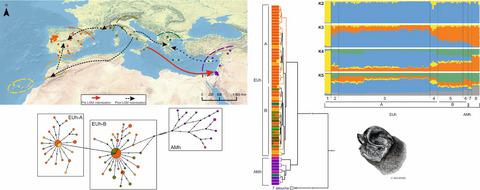当前位置:
X-MOL 学术
›
J. Zool. Syst. Evol. Res.
›
论文详情
Our official English website, www.x-mol.net, welcomes your
feedback! (Note: you will need to create a separate account there.)
Evolutionary history of the European free‐tailed bat, a tropical affinity species spanning across the Mediterranean Basin
Journal of Zoological Systematics and Evolutionary Research ( IF 2.0 ) Pub Date : 2019-11-25 , DOI: 10.1111/jzs.12326 Francisco Amorim 1, 2 , Orly Razgour 3 , Vanessa A. Mata 1, 2 , Susana Lopes 1 , Raquel Godinho 1, 2, 4 , Carlos Ibáñez 5 , Javier Juste 5 , Stephen J. Rossiter 6 , Pedro Beja 1, 7 , Hugo Rebelo 1, 7
Journal of Zoological Systematics and Evolutionary Research ( IF 2.0 ) Pub Date : 2019-11-25 , DOI: 10.1111/jzs.12326 Francisco Amorim 1, 2 , Orly Razgour 3 , Vanessa A. Mata 1, 2 , Susana Lopes 1 , Raquel Godinho 1, 2, 4 , Carlos Ibáñez 5 , Javier Juste 5 , Stephen J. Rossiter 6 , Pedro Beja 1, 7 , Hugo Rebelo 1, 7
Affiliation

|
The Mediterranean Basin is a global biodiversity hotspot, hosting a number of native species belonging to families that are found almost exclusively in tropical climates. Yet, whether or not these taxa were able to survive in the Mediterranean region during the Quaternary climatic oscillations remains unknown. Focusing on the European free‐tailed bat (Tadarida teniotis), we aimed to (a) identify potential ancient populations and glacial refugia; (b) determine the post‐glacial colonization routes across the Mediterranean; and (c) evaluate current population structure and demography. Mitochondrial and nuclear markers were used to understand T. teniotis evolutionary and demographic history. We show that T. teniotis is likely restricted to the Western Palearctic, with mitochondrial phylogeny suggesting a split between an Anatolian/Middle East clade and a European clade. Nuclear data pointed to three genetic populations, one of which is an isolated and highly differentiated group in the Canary Islands, another distributed across Iberia, Morocco, and France, and a third stretching from Italy to the east, with admixture following a pattern of isolation by distance. Evolutionary and demographic reconstruction supports a pre‐Last Glacial Maximum (LGM) colonization of Italy and the Anatolian/Middle East, while the remaining populations were colonized from Italy after the Younger Dryas. We also found support for demographic expansion following the Iberian colonization. The results show that during the LGM T. teniotis persisted in Mediterranean refugia and has subsequently expanded to its current circum‐Mediterranean range. Our findings raise questions regarding the physiological and ecological traits that enabled species with tropical affinities to survive in colder climates.
中文翻译:

欧洲无尾蝙蝠的进化史,一种横跨地中海盆地的热带亲和物种
地中海盆地是全球生物多样性的热点地区,拥有许多几乎属于热带气候的家庭原生物种。然而,这些类群是否能够在第四纪气候振荡期间在地中海地区生存仍然未知。我们着眼于欧洲的无尾蝙蝠(Tadarida teniotis),旨在(a)识别潜在的古代种群和冰川避难所;(b)确定整个地中海的冰川后殖民路线;(c)评估当前的人口结构和人口统计。线粒体和核标记物被用来了解棉铃虫的进化和人口历史。我们证明T. teniotis线粒体的系统发育表明,安那托利亚/中东进化枝和欧洲进化枝之间存在分裂。核数据指向三个遗传种群,其中一个是加那利群岛的一个孤立且高度分化的群体,另一个分布在伊比利亚,摩洛哥和法国,第三个从意大利向东方延伸,并遵循孤立模式按距离。进化和人口重建支持了意大利和安那托利亚/中东地区的上一个冰川最大时期(LGM)之前的殖民地,而剩余的人口是在年轻的德里亚斯之后从意大利殖民的。在伊比利亚殖民之后,我们还发现了对人口扩展的支持。结果表明,在LGM T. teniotis期间一直坚持地中海避难所,后来扩展到目前的地中海地区。我们的发现提出了有关生理和生态特征的问题,这些特征使具有热带亲和力的物种能够在较冷的气候下生存。
更新日期:2019-11-25
中文翻译:

欧洲无尾蝙蝠的进化史,一种横跨地中海盆地的热带亲和物种
地中海盆地是全球生物多样性的热点地区,拥有许多几乎属于热带气候的家庭原生物种。然而,这些类群是否能够在第四纪气候振荡期间在地中海地区生存仍然未知。我们着眼于欧洲的无尾蝙蝠(Tadarida teniotis),旨在(a)识别潜在的古代种群和冰川避难所;(b)确定整个地中海的冰川后殖民路线;(c)评估当前的人口结构和人口统计。线粒体和核标记物被用来了解棉铃虫的进化和人口历史。我们证明T. teniotis线粒体的系统发育表明,安那托利亚/中东进化枝和欧洲进化枝之间存在分裂。核数据指向三个遗传种群,其中一个是加那利群岛的一个孤立且高度分化的群体,另一个分布在伊比利亚,摩洛哥和法国,第三个从意大利向东方延伸,并遵循孤立模式按距离。进化和人口重建支持了意大利和安那托利亚/中东地区的上一个冰川最大时期(LGM)之前的殖民地,而剩余的人口是在年轻的德里亚斯之后从意大利殖民的。在伊比利亚殖民之后,我们还发现了对人口扩展的支持。结果表明,在LGM T. teniotis期间一直坚持地中海避难所,后来扩展到目前的地中海地区。我们的发现提出了有关生理和生态特征的问题,这些特征使具有热带亲和力的物种能够在较冷的气候下生存。











































 京公网安备 11010802027423号
京公网安备 11010802027423号